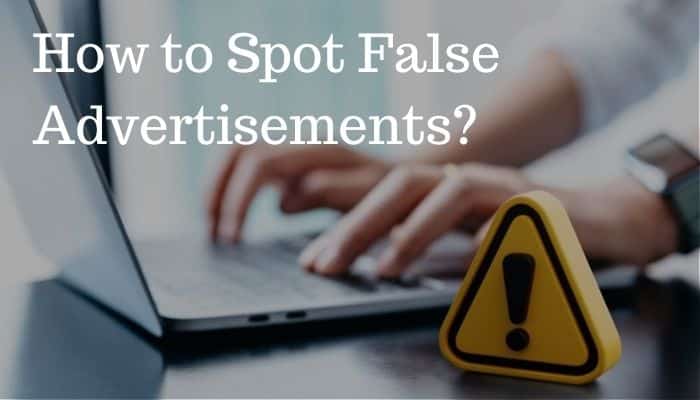Have you ever heard the phrase, "All that glitters is not gold"? This means that something may look great on the surface but may not be if you take a closer look. Sounds a whole lot familiar? Then you may be thinking about bogus adverts. Unfortunately, with the plethora of deceptive marketing tactics, it can be hard to distinguish what's truthful from what's misleading. The good news is that you can protect yourself with these tips and tricks to help you spot false ads effectively.
The Definition of false advertising
Before we proceed, let's define what false advertising is. Is it the same as unacceptable advertising?
Although the two overlap, they have different meanings. All false advertisements are unacceptable. However, not all unacceptable ads are false. Untruthful marketing refers to making inaccurate or misleading claims in adverts to dupe consumers. This can include erroneous statements about a product's price, quality, performance, or ingredients, among other things. This type of marketing primarily aims to manipulate consumers into buying a product or service they might not purchase otherwise.
Unacceptable advertising, on the other hand, refers to that which doesn't comply with moral or legal norms. This can include commercials or promotions that:
use offensive language or imagery
exploit vulnerable populations
spread misinformation
violate privacy laws.
Although they can be incorrect or fallacious, unlike the fraudulent type, the intent of unacceptable marketing is not necessarily to deceive consumers. Instead, it is to promote offerings or merchandise in a way that is unethical or violates industry standards.
The negative effects of fake advertising
You may not be aware of it, but false advertising is a prevalent problem. Many digital ads trick users into clicking on them. As a result, the credibility of any marketing info, including those that are genuine and useful, can be eroded.
Take the case of online personalities. Influencer marketing can either make or break a brand's reputation. Deceitful promos or insincere reviews from internet stars can significantly harm a brand's image and credibility. However, the reverse is also true; Authentic and positive reviews from trusted social media influencers can vastly boost reputation and increase consumer trust and loyalty.
Fake advertising can lead to even more undesirable outcomes. For instance, unsuspecting customers can download malware or sign up for scams. This can lead to negative user experiences, data breaches, and financial losses. Thus, to maintain the credibility and effectiveness of online adverts, it's crucial to detect inaccuracies and promote industry transparency and accountability. Concerning influencers, brands must carefully select their ambassadors. They should also monitor online releases. This ensures that everything aligns with the brand's values and truly represents its products or services.
Tips on spotting false ads
Stay one step ahead with these effective ways to ensure you get nothing but the best bang for your buck!
1. Check if the advert is paid or earned media.
Not all sponsored ads are suspect. However, you have a higher chance that something is true if algorithms recommend it. This is because companies can only grow earned media through authenticity.
Adhering to a brand's core values and offerings creates a magnetic pull for customers seeking honesty and reliability. By consistently delivering on promises, a brand fosters trust and establishes a positive reputation. This draws in loyal customers who appreciate a genuine and dependable experience. The result is a virtuous cycle, as satisfied customers become brand ambassadors who naturally attract even more customers.
2. Look for inconsistencies in the details.
Scrutinizing ads for discrepancies, such as misspelled words or incorrect information, can reveal their authenticity. By detecting these inconsistencies, you can protect yourself from falling for fraudulent adverts. Reputable companies are also more likely to hire the services of a professional video editing and web design company, such as Brand Beavers.
3. Verify the source.
By researching the website or company behind the ad, you can establish its credibility and legitimacy. Taking the time to validate the source can enable you to make an informed decision.
4. Search for reviews.
First-hand experiences from past customers can get you a sense of the product's performance, customer satisfaction, and any potential red flags. This research can also provide a balanced perspective, helping you avoid costly mistakes.
5. Watch out for extreme deals or prices.
Research the product or service online and compare prices with other reputable sources. Beware of advertisements offering over-the-top offers, as they may be designed to lure you into a scam. Trust your instincts. And if something seems too good to be true, it probably is.
6. Check if the product’s website has a physical address and phone number.
A legitimate business will typically have transparent contact information. In contrast, a fake advertisement may have incomplete or even confusing details.
7. Look out for dubious flaws in the website's design.
These can include a lack of security certificates, a privacy policy, and a dedicated page for terms and conditions. The absence of any of these indicators can demonstrate a lack of credibility and raise suspicions about the safety of your personal information.
8. Scrutinize the product's image and see if it’s been used elsewhere.
A fake advertisement may use stock images while a legitimate ad will feature original, high-quality photos of the product.
What to do when you experience false advertising
The next logical question would be to find out what you can do should you encounter or fall prey to fake ads. Can your customers get a refund? Can you sue for untruthfulness?
Fortunately, you can report fraudulent advertisements to the appropriate authorities, such as the FTC or Federal Trade Commission in the US. Additionally, if you have already purchased a product based on false information, you may be entitled to a refund. You can also seek legal action if such has caused you harm. To support your case, it is crucial to gather evidence and document the deceitful claims made by the advertisement. These steps can help hold companies accountable for their actions and prevent others from being victimized.
Final thoughts
In conclusion, spotting fake ads requires a combination of research, critical thinking, and caution. Following the tips we shared can help you identify and avoid fraudulent advertisements and make informed purchasing decisions. With these tools at your disposal, you can protect yourself from being misled and ensure that your hard-earned money is well spent.






